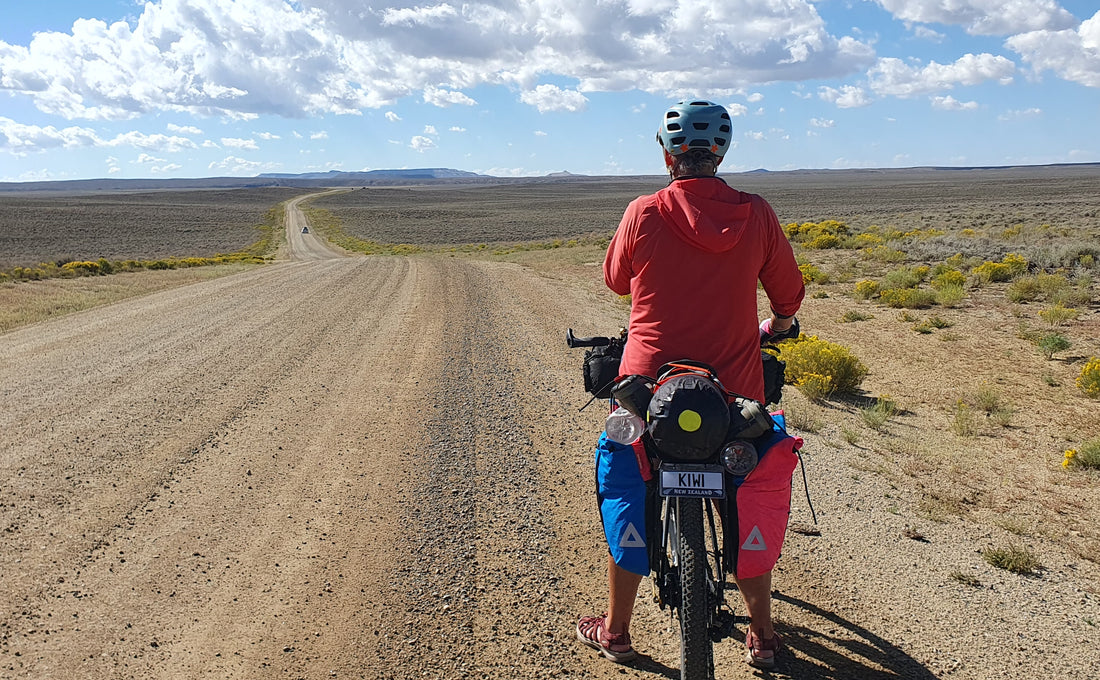Product Testing on the GDMTBR

Around June this year, Paper Roads reached a milestone with the build of a laser cutter which meant products could be produced efficiently and those that needed improvement could be revised to include the use of polypropylene plastic.
Racing time (as always) the Ranger Harness went through redesign to be made of plastic, but even with about 30 of the previous fabric versions having been sold without any reported failure (and personally used), as a designer and bikepacker, I was reluctant to announce a revised product such as a harness without having test-run it in the wild.
The Tour Divide riders had mostly left for the US around that time and I was scrambling to hitch a ride for the Ranger Harness on someone's bike. If anyone volunteered, I wasn't going to be picky.
Enter Juliet from Hanmer Springs, who came to save the day. She was to ride 4000km with her husband Grum (who writes very well on Grumgoesglobal Facebook page) from Jasper, Alberta to Cuba in New Mexico. Now this couple aren't going to shred trails or be in any hurry. They are in the upper end of the age demographic and were to take 65 days.

Normally, if you were to test gear, you'd find the racers, the shredders and someone who's likely to break things. Later on, I realised Juliet's trip was a great test trip.
Paper Roads gave her a prototype front harness with a 14L Overland front roll (made in Ultra200X) - the maximum size recommended to be carried in the harness. Juliet had previously purchased the Trail Panniers in Ecopak200 (with old backing plate design) and she also used these. Ecopak200 is the lightest weight fabric that Trail Panniers can be made in, and if I was riding 4000km with it packed fuller than it's supposed to be, I would've considered Ecopak400 or Ultra200 or 400.
Lucikly Juliet was just tall enough to fit the 14L front roll over her front wheel, which meant wheel rub occurred over rough patches and tested how the Ultra200 stood up to the scuffing. She also stuffed it to the brim with an unexpected purchase of a massive sleeping mat halfway through the trip.
The Trail Panniers were also stuffed to the top. The velcro closures probably tempts people to pack, pack and pack, but they're only supposed to be 8L micro panniers designed for riding trails!

With both front and back bags fully stuffed to maximum capacity and stretched to the extremes of what they were designed to do, it was a relief to hear they stood up to the 'overloading' test (even the old panniers backing plate design). A little hole was reported in the panniers, which Juliet blames as her packing problem, but she was diligent in drybagging the contents so I'd note that as the fabric being too light for such a punishing bikepacking journey.
Conditions were hot and dusty, with hail and periods of rain for no more than an hour at a time. Surprisingly, the Ecopak200 in the panniers never really soaked through (being ripstop backing, not laminated RPET plastic, water is expected to soak through sometime but it's coated in water-repelling DWR too).
Another unforeseen benefit of testing on a 65 day tour of the GDMTBR and not in the pointy end of the race, is the repeated packing and unpacking of gear for 65 days. Fastenings were tested, seams and general durability.

Many more Paper Roads pieces went on the GDMTBR this year and there was one reported problem from a stressed sounding rider saying a hole had been worn in their Ultra200X dry roll in a rear harness, by grit. I responded to the email to try and detect what really wore the hole, and that if they carried 1m of gaffer tape, it can be taped from the inside. Nothing more was heard. There was a 1cm slit worn in the same product by someone else earlier this year and it was sitting on a sawn-off metal strut on a rack for 3000km...bikepacking and using ultra-light gear does require proper packing and attention to your setup.
Thanks Juliet for choosing Paper Roads and for the photos!
